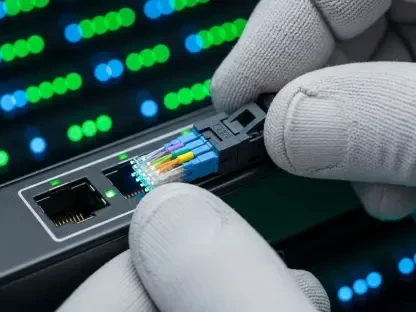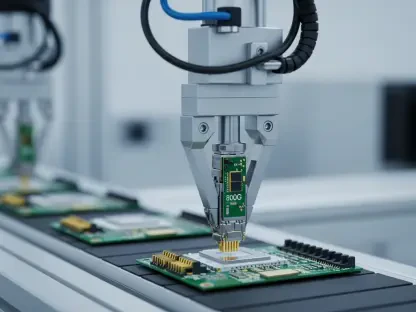In a world increasingly driven by digital innovation, integrating AI with robust connectivity solutions has become imperative. Leaders Ericsson and Supermicro have joined forces to push the boundaries of Edge AI through 5G technology. This collaboration marks a significant shift in how AI applications are deployed, offering a new horizon of low-latency solutions that cater to various sectors. With a memorandum of understanding securing the partnership, these industry giants aim to revolutionize how real-time data processing is accomplished at the network edge, thereby eliminating reliance on centralized data centers, which often hinder speed and efficiency.
Empowering Industries with Advanced Connectivity
The Role of 5G in AI Evolution
The synergy between Ericsson’s 5G technology and Supermicro’s computing platforms serves as a catalyst for progress in numerous industries, enabling applications to strengthen and perform with exceptional agility and efficacy. 5G’s integration in AI processes fundamentally transforms application responsiveness, which is crucial for industries that require swift, almost instantaneous reactions to dynamic changes in their environments. This is achieved by executing AI models locally at the network edge instead of relying on distant data centers, mitigating latency and enhancing efficiency.
Through 5G’s cutting-edge capabilities, sectors such as healthcare, retail, and industrial automation can explore new possibilities. For instance, rapid AI deployment in retail can significantly improve checkout and inventory management processes by swiftly analyzing sales data and adjusting stock levels in real time. In healthcare, AI-enhanced 5G connectivity enables prompt monitoring of medical devices and patient data, improving service delivery. Industrial automation benefits from real-time equipment monitoring and predictive maintenance, leading to higher productivity and minimal downtime. The trend toward edge computing exemplifies a broader movement toward efficient data processing and management, pertinent to Ericsson and Supermicro’s strategic objectives.
Practical Implementation and Industry Impacts
The deployment of AI applications at the edge offers unparalleled flexibility, allowing solutions to be tailored to specific contexts or environments that lack reliable wired connectivity. The capacity to deliver high data throughput, similar to conventional wired systems yet more adaptable, addresses significant challenges faced by industries operating in remote or wireless-deficient locations. As businesses and public sector entities increasingly adopt edge technologies, commercial bundles that seamlessly combine AI computing with 5G connectivity are simplifying procurement and deployment.
With these technological advancements, industries can implement smart intersections in urban settings, enhance traffic management systems with real-time data analytics, and support logistical operations in healthcare and supply chains effectively. For example, smart intersection technology with AI can analyze traffic patterns accurately, ensuring smooth traffic flow and increasing safety. In healthcare supply chains, AI-integrated systems facilitate the monitoring of pharmaceutical supplies, ensuring timely replenishment and reducing waste. These use cases underscore the advantages of edge AI, driving industries forward by offering robust solutions to modern challenges.
Strategic Vision for Future Deployments
Creating a Flexible and Efficient Edge Environment
The vision articulated by Ericsson and Supermicro encapsulates a commitment to redefining how businesses harness edge intelligence, facilitating seamless procurement, deployment, and management of technological solutions. With the aid of 5G’s advancements, enterprises are empowered to bypass traditional wired dependencies, forging paths toward more agile and responsive operational strategies. As organizations strive to stay at the forefront of technological innovation, the capabilities offered by this collaboration allow them to adapt swiftly and efficiently to changing demands in a hyper-connected world.
By adopting Ericsson’s and Supermicro’s cutting-edge solutions, companies can revolutionize their network architectures, implementing systems that provide unmatched speed, reliability, and security. Features such as network slicing and cellular intelligence play critical roles in ensuring that business-critical deployments are not only efficient but resilient against potential disruptions. This transformative impact extends to both public and private sectors, supporting initiatives aimed at achieving smarter, more connected societies while promoting sustainable growth.
Commitment to a Sustainable Technological Future
In today’s world, where digital innovation drives progress, the integration of artificial intelligence with advanced connectivity solutions is crucial. Industry leaders Ericsson and Supermicro have partnered to explore the vast capabilities of Edge AI powered by 5G technology. This cooperation heralds a transformative approach to deploying AI applications, introducing low-latency solutions that benefit various industries. With a memorandum of understanding formalizing their alliance, these tech giants aim to transform how real-time data is processed at the network’s edge, reducing dependency on centralized data centers, which can slow down operations and decrease efficiency. By pushing AI capabilities to the edge, they are setting the stage for unprecedented advancements in sectors like healthcare, manufacturing, transportation, and entertainment, where real-time data processing is pivotal. The collaboration is poised to unlock new possibilities, driving digital transformation and enhancing the way people interact with technology on a daily basis.









